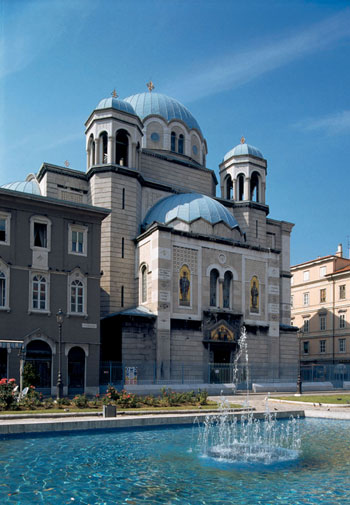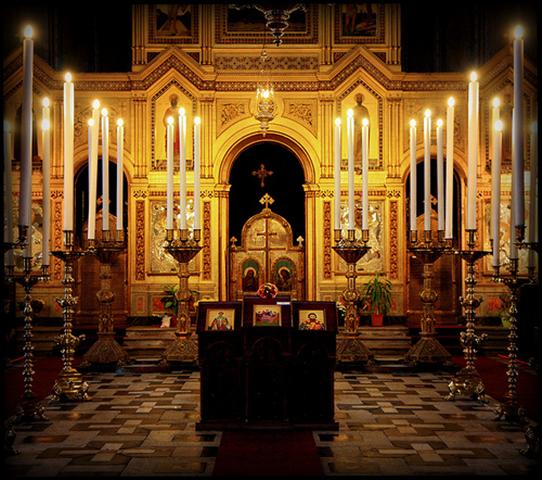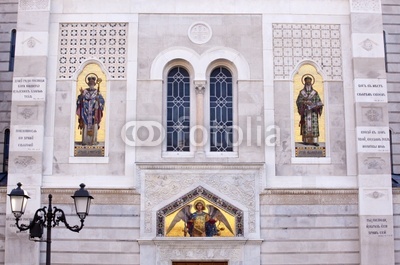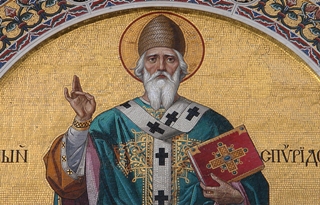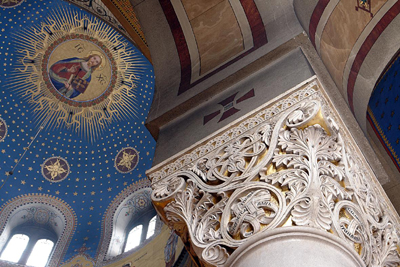chiesa Serbo Ortodossa di San Spiridione (1861 - 1869)
tra Via S.Spiridione e via Genova
Arch. Carlo Maciachini
The church dedicated to San Spiridione of the Serbian-Orthodox Community stands near Piazza S. Antonio. The structure of the building, with a Greek cross plan covered by a large dome supported by four arches and flanked by four hemispherical caps covering the four arms of the cross, recalls the Byzantine style of the eastern churches; it has a height of 40 meters. The temple was opened for worship on September 2, 1868 and can accommodate around 1600 faithful.
The stone used for the construction comes from the quarries of Santa Croce, a local quarry, and from those of Brioni in Istria; the columns of the facade are in red Verona marble and the Tuscan marble cornices. The interior is decorated with fine frescoes and paintings on an oil background.
The church is consecrated to S. Spiridione Thaumaturgo. It was erected over a hundred years ago by the devotion of the Serbs who already founded their religious community in Trieste.
Thanks to their noble interest and donations, these Serbian devotees made it possible that in the welcoming city of Trieste, then under the sovereignty of the Austro-Hungarian Empire, this majestic church was erected as a place of prayer and to preserve the faith of the their fathers.
Since 1918 the church of S.Spiridione and the Eastern Christian cult - have been under the protection of Italian laws which guarantee their freedom and autonomy.
The temple is built in the oriental tradition in the shape of a cross, with five domes, in the Serbian - Byzantine style. The temple has a height of 40 meters, is 38 meters long and 31 meters wide. It can accommodate 1600 faithful.
The building stands on the foundations of the old Orthodox church built in the first half of the 18th century. The works for the construction of the new temple continued from 1861 to 1869. The project was developed by the famous Milanese architect Carlo Maciachini, while the direction of the works was entrusted to Pietro Palese from Trieste and the Milanese decorator Antonio Caremi. Another great Lombard artist Giuseppe Bertini was entrusted with the execution of the temple paintings. The stone with which it is built comes from the quarries of Santa Croce, on the Trieste Karst, and from the quarries of the Brijuni Island, in Istria. Some columns on the external facades are in red Verona marble and the cornices in Tuscany marble.
The interior of the temple is decorated with fine frescoes and oil paintings. Above the Sacred Table and the altar there is a large image of Christ on the throne with the twelve apostles.
On the right side of the temple is the Assumption of the Virgin. The first ecumenical council of Nicea held in 325 is depicted on the left. The holy fathers can be seen under the symbolic presidency of S.Spiridione, patron of this temple. On the western part of the church is the sarcophagus of S.Spiridione, which is located on the island of Corfu, where its relics are still preserved today.
The iconostasis that divides the presbytery from the rest of the church is in solid wood, decorated with a rich carved ornamentation. In the first row at the bottom there are four large icons of exceptional value and great artistic value: they depict the Madonna, Jesus Christ, S.Spiridione and the Annuciation. These icons were made in Russia in the early 1800s, are covered in gold and silver, and originally they were already located in the old pre-existing temple. In the upper row of the iconostasis there are the iconographic representations of the Serbian saints: 5. Simone Mirotocivi, S Sava, S. Stefano Prvovencani and Tsar Uros. In the upper third row are the images of the Baptism of Christ, of his Crucifixion and Resurrection. The whole altar is adorned with valuable works by famous iconographers and artists.
Inside the temple, the large silver candlestick, donated by the Russian prince - who later became tsar, - Paolo Petrovic 'Romanov, during his visit to Trieste, in January 1772, is particularly noteworthy. The Russian countess Julija Samojlòva ha donated to the temple a gospel covered in gold, also of Russian manufacture, and precious priestly vestments. There are over 100 icons in the temple, some of which are very old. Of particular value are two Gospels, half a meter long and thirty centimeters thick, with artistically embossed silver covers. Both Gospels were executed in 1797 by Venetian craftsmen.
For its particular beauty and exceptional artistic value, the temple of S. Spiridione has been placed under the protection of the Law for the protection of artistic monuments in Italy, and represents one of the most admired and characteristic architectural monuments of Trieste.
Origins
As is known from the history of the Church, Christianity was already persecuted by the Roman Empire from its beginnings. During the period of persecutions, which lasted about three centuries, many Christian martyrs suffered from the faith. In the year 313 the emperor Constantine published a decree in Milan that granted freedom to the Christian religion.
Immediately after Christianity gained freedom in the Roman Empire, many heresies and various dogmatic conceptions manifested one after the other, which subsequently long disturbed the life of the Church.
Between the ninth and eleventh centuries, conflicts arose between representatives of western and eastern Christianity, between the Popes of Rome and the Eastern Patriarchs and in particular with the Patriarch of Constantinople.
However, the controversy did not concern serious dogmatic divergences or ethical conceptions (these divergences subsequently increased), but in this circumstance an ecclesiastical - juridical and ecclesiastical - political divergence broke out with all its force. The conflict was made more serious by cultural and national differences between the Greek East and the Latin West.
The main reason for the conflict was the struggle for primacy and power. The West brought historical and theological arguments by asserting that the Popes of Rome had juridical - canonical authority from the beginning of Christianity and that they had received it from the Apostle Peter and that Peter had received it from Christ himself. And in this they referred to the Gospel text of Matthew 16:19 - I will give you the keys of the kingdom of heaven4 and everything you bind on earth will be tied in the heavens and everything you untie on earth will be melted in the heavens. The East did not even want to hear about such matters (see Mat. 18:18 - Christian forgiveness.) In truth I say to you: everything you bind above the earth will also be bound in heaven and everything you untie above the earth will be dissolved also in heaven.) All this, together with other canonical - disciplinary, liturgical and dogmatic divergences, Eastern theology proclaimed western innovations unknown to the Eastern Church and to the whole Church of the origins.
For example, the Creed of the Western Church differs from that of the Eastern Church in the eighth article, which in Orthodoxy is thus conceived: "I believe in the Holy Spirit, Lord, bearer of life, who proceeds from the Father", while in the Western Church it is added "that he proceeds from the Father and the Son".
In reality, the Orthodox Church has preserved the primitive formula of the Creed, which is based on the words of Jesus: "the comforter ... Spirit of Truth, who proceeds from the Father" (cf. Jn 15:26).
The contrasts between East and West lasted, with interruptions over time and pacifications, from the mid-ninth century to 1054, when with mutual anathema the Pope and the Patriarch of Constantinople excommunicated each other and declared the part schismatic and even heretical adverse. Since that time there are two forms of Christianity: the Eastern or ecumenical one, the Western or Roman - Catholic one.
Among them there were also previously some insignificant differences, but after the break of 1054 these differences that increased more and more not only in the liturgical sphere, but also in the dogmatic one. The Orthodox have not accepted the new dogmatic formulations of the Roman Catholic Church. The historical - political events over the following centuries have often provoked an authentic atmosphere of bloody controversy between Western and Eastern Christians.
In the sec. In the context of western Christianity, the Reformation revolted. In this way, alongside the already existing forms of Orthodox and Roman Catholic Christianity, a third form of Christianity is affirmed, Protestantism.




